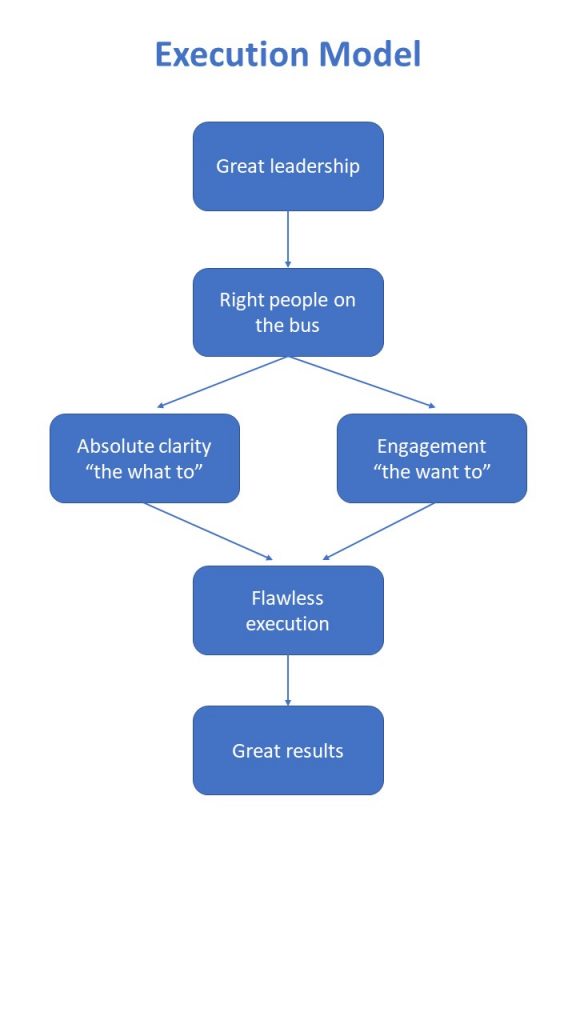Building Engagement
Reflections:
Let’s return to the Execution model. Last week we examined clarity- the what to and how to. This week we consider engagement- the want to.
 In Lead Like Mary I explore the thought that people engage at four different levels- their body, heart, mind and spirit.
In Lead Like Mary I explore the thought that people engage at four different levels- their body, heart, mind and spirit.
When our body is engaged our physical needs are met. We are paid a reasonable wage for the job we are doing, there are other benefits in place (typical examples would be holiday entitlement, sick pay, maternity pay, pension etc.), we have a safe working environment and the basic skills and tools we need to do the job.
When our heart is engaged our social and emotional needs are met. We are treated with respect at work, are recognized and praised for a job well done, and although work is a serious business we have some fun there as well.
When our mind is engaged we are asked for ideas on how things could be done better at work. We are given freedom within a framework, we are given the opportunity for personal development and to learn new skills, we are encouraged to take on more responsibility and new challenges, where appropriate a career plan set out for us.
Our spirit is the highest level of engagement. Now we really feel we are part of an important purpose, we are making a difference with the work we do. We work for an organisation with values similar to our own, we are inspired by the work we are doing and given the opportunity to make a meaningful contribution.
It is rare to come across people who feel fully engaged at all four levels but when I come across it I see amazing people delivering amazing results.
The four dimensions of engagement
Empowering our people is crucial to ensuring they are engaged, but it is only part of the story. In his work on leadership in his book “The 8th Habit”, Stephen Covey argues that people give their best when they are fully engaged, that it is possible to engage our people at four levels; their body, heart, mind and spirit. There is too much depth here to go in to full detail, and the book is well worth further examination, but each level can be summarised as follows:
When we engage someone’s body we are at the entry level of engagement (there are close links to Maslow’s hierarchy of needs). We pay them a reasonable and fair wage for the job they are doing, we give them appropriate additional benefits to their employment, we give them the basic knowledge, skills and tools they need to do the job and we provide them with a safe working environment. Pretty basic needs, but we cannot hope to begin to engage our people unless these are in place.
We can do so much more, for we can also engage the heart. Now, we treat our people with respect, we praise them for a job well done whenever it is deserved (always being genuine) and we create a fun working environment, where coming to work becomes enjoyable.
Incidentally, a fun working environment can be created anywhere and is completely consistent with doing serious work. It’s not about red noses and clown outfits, it’s about having a laugh at work, working amongst friends, some social activity and can exist anywhere within any disciplined framework. I previously did some work for a high street bank. Their counter staff have a responsible job handling vast amounts of money. It’s a serious business needing sensible, conscientious and diligent people. We succeeded nevertheless, in creating an environment where these people had fun at the same time.
So, we must engage our people’s hearts, but we can do more – we can also engage their minds and this is what far too many organisations fail to do. It’s such an easy win. When we engage the mind, we listen to our people, we want their ideas for improving things. We give them challenging assignments, we empower them, we want to give them more responsibility and unlock their potential. We want to give our people enhanced knowledge and skill, wherever appropriate we set out a career path for them. We want them to grow and flourish.
Finally, the highest level of engagement is when we can engage someone’s spirit. This is a little more difficult to explain, but when we achieve this we have engaged something deep inside the person. This begins to happen when people genuinely believe they are doing worthwhile work. They can see a link between what they are doing and the delivery of the team’s and organisation’s vision and purpose. Now, people believe they are doing important work. We work hard to ensure there is a link between the values an individual holds dear and what a whole organisation stands for and demonstrates. Ultimately, we fully engage people when they feel they are contributing to a noble purpose.
